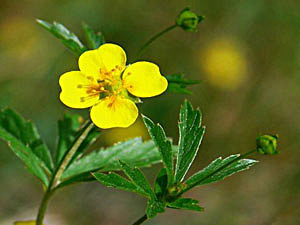
medicinal herbs
Tormentil
Potentilla erecta

Herb: Tormentil
Latin name: Potentilla erecta
Synonyms: Potentilla tormentilla
Family: Rosaceae (Rose Family)
Medicinal use of Tormentil:
Containing more tannin than oak bark, all parts of tormentil are strongly astringent, finding use wherever that action is required. This plant is considered to be one of the safest native astringents and it is widely used in herbal medicine in the treatment of diarrhoea, dysentery, sore throats etc. The whole plant, and especially the root, is antibiotic, strongly astringent, haemostatic and hypoglycaemic. It is used in the treatment of diarrhoea, dysentery, irritable bowel syndrome, colitis, ulcerative colitis etc. Externally, the plant makes a good styptic for cuts etc., and a strongly made decoction has been recommended as a wash for mouth ulcers, infected gums, piles and inflamed eyes. Extracts are used to treat chapping of the anus and cracked nipples. The plant's effectiveness as a toothache remedy is undeniable and it has also been of benefit in treating bed-wetting by children.Description of the plant:

Plant:
Perennial
Height:
30 cm(11 3/4 inch)

Flowering:
June toSeptember
Habitat of the herb:
Grassland, heath, bog, fens, mountain tops and open woods, especially in light acid soils.Edible parts of Tormentil:
The roots are extremely rich in tannin, long boiling converts this into a gum and it can then be eaten . An emergency food, it is only eaten when all else fails. A tea is made from the rhizomes.Other uses of the herb:
A red dye is obtained from the roots. The plant, and especially the root, is rich in tannin. It s used cosmetically as a compress to tone up flabby skin. The root contains up to 20% tannin.Propagation of Tormentil:
Seed - sow early spring or autumn in a cold frame. When they are large enough to handle, prick the seedlings out into individual pots and grow them on in the greenhouse for their first winter. Plant them out into their permanent positions in late spring or early summer, after the last expected frosts. Division in spring. Larger divisions can be planted out direct into their permanent positions. We have found that it is better to pot up the smaller divisions and grow them on in light shade in a cold frame until they are well established before planting them out in late spring or early summer.Cultivation of the herb:
Grassland, heath, bog, fens, mountain tops and open woods, especially in light acid soils.Known hazards of Potentilla erecta:
None knownPlant information taken from the Plants For A Future.
